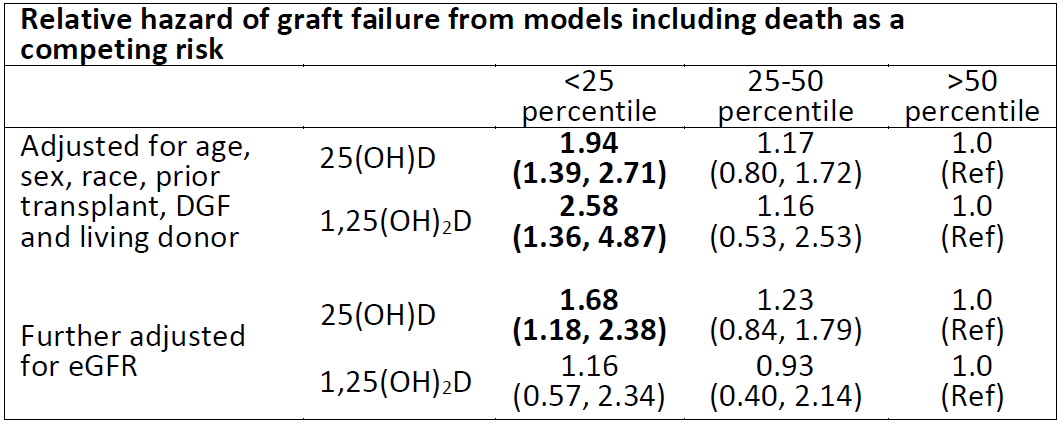25-Hydroxyvitamin D [25(OH)D], but Not 1,25-Dihydroxyvitamin D [1,25(OH)2D], Independently Predicts Kidney Graft Failure: The Wisconsin Allograft Recipient Database (WisARD).
1University of Wisconsin School of Medicine and Public Health, Madison, WI
2Albert Einstein College of Medicine / Montefiore Medical Center, Bronx, NY
Meeting: 2017 American Transplant Congress
Abstract number: D271
Keywords: Graft failure, Kidney transplantation
Session Information
Session Name: Poster Session D: Long Term Kidney Outcomes
Session Type: Poster Session
Date: Tuesday, May 2, 2017
Session Time: 6:00pm-7:00pm
 Presentation Time: 6:00pm-7:00pm
Presentation Time: 6:00pm-7:00pm
Location: Hall D1
Vitamin D deficiency is common in chronic kidney disease and is associated with cardiovascular events and mortality. Kidney transplant recipients are at elevated risk of vitamin D deficiency, but few studies have assessed its association with graft survival. It remains unclear whether associations with outcomes differ for 25-Hydroxyvitamin D [25(OH)D] compared to its active form, 1,25-Dihydroxyvitamin D [1,25(OH)2D].
We assessed the relationship of the earliest 25(OH)D measurement, from 3-60 months (mean of 19 months) post-transplant, with graft survival in 1351 kidney transplant recipients from 2000-2014. A total of 268 recipients also had 1,25(OH)2D measured. Estimated glomerular filtration rate (eGFR) was measured within 30 days of 25(OH)D and those with eGFR <15 mL/min/1.73m2 (n=24) were excluded.
25(OH)D and 1,25(OH)2D were weakly correlated (0.16; p=0.02). eGFR was more strongly correlated with 1,25(OH)2D (0.35; p<0.001) than 25(OH)D (0.05; p=0.05). A total of 190 graft failures and 267 deaths occurred over a median of 27.8 months of follow-up (55 graft failures and 65 deaths among those with 1,25(OH)2D measured). Lower 25(OH)D and lower 1,25(OH)2D were significantly associated with the risk of graft failure in competing risk models. Further adjustment for eGFR strongly attenuated the association of 1,25(OH)2D with graft failure, while lower 25(OH)D remained associated with risk of graft failure. 25(OH)D and 1,25(OH)2D are only weakly correlated in kidney transplant recipients and 1,25(OH)2D is more strongly correlated with graft function. Lower 25(OH)D is an independent predictor of graft failure, while the association of 1,25(OH)2D with graft failure is not independent of graft function. Additional studies including repeated measures of 25(OH)D and 1,25(OH)2D, specific causes of graft failure, and other outcomes are required to determine whether these relationships may be causal and modifiable.
25(OH)D and 1,25(OH)2D are only weakly correlated in kidney transplant recipients and 1,25(OH)2D is more strongly correlated with graft function. Lower 25(OH)D is an independent predictor of graft failure, while the association of 1,25(OH)2D with graft failure is not independent of graft function. Additional studies including repeated measures of 25(OH)D and 1,25(OH)2D, specific causes of graft failure, and other outcomes are required to determine whether these relationships may be causal and modifiable.
CITATION INFORMATION: Astor B, Melamed M, Mandelbrot D, Djamali A. 25-Hydroxyvitamin D [25(OH)D], but Not 1,25-Dihydroxyvitamin D [1,25(OH)2D], Independently Predicts Kidney Graft Failure: The Wisconsin Allograft Recipient Database (WisARD). Am J Transplant. 2017;17 (suppl 3).
To cite this abstract in AMA style:
Astor B, Melamed M, Mandelbrot D, Djamali A. 25-Hydroxyvitamin D [25(OH)D], but Not 1,25-Dihydroxyvitamin D [1,25(OH)2D], Independently Predicts Kidney Graft Failure: The Wisconsin Allograft Recipient Database (WisARD). [abstract]. Am J Transplant. 2017; 17 (suppl 3). https://atcmeetingabstracts.com/abstract/25-hydroxyvitamin-d-25ohd-but-not-125-dihydroxyvitamin-d-125oh2d-independently-predicts-kidney-graft-failure-the-wisconsin-allograft-recipient-database-wisard/. Accessed December 23, 2025.« Back to 2017 American Transplant Congress
